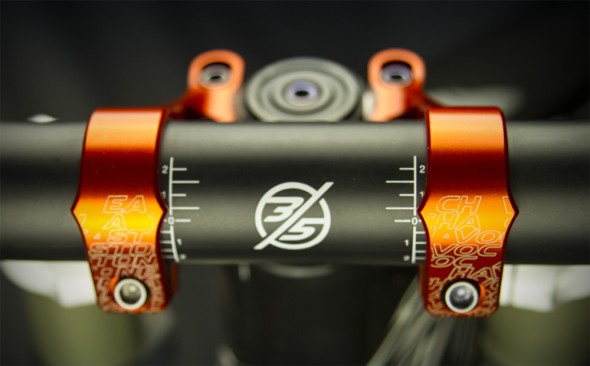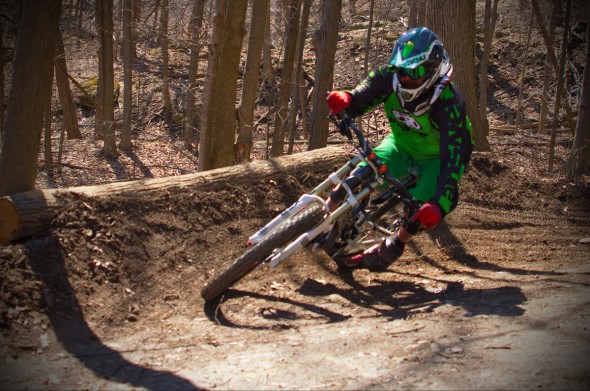Not too long ago, Easton spec’d their Havoc Carbon bar at 750mm wide, but with demands from riders and bike manufactures for wider bars, Easton needed to do something. After extensive testing of a longer 31.8mm diameter bar, Easton concluded that in order to achieve their design parameters (weight, length, and stiffness), something drastic had to be done. The designers finally settled on a larger 35mm clamp diameter in the center section with a tuned taper all the way to the ends to satisfy all their requirements. The new Havoc bars are a full 50mm wider at 800mm, yet lighter and stiffer than the previous design.
Just watching the video above gives you a sense of what all Easton products, not just the Havoc bar, are put up against. The new Havoc carbon bar comes in at a scant 220g (a decent alloy XC bar is still at least 20g heavier) which is crazy light for a DH bar. To put that in perspective, the Havoc 35 bar and direct mount stem together weigh less than most alloy DH bars on the market.
The bar itself is made from Easton’s EA90 UD carbon using taper bore technology. A familiar 9-degree back sweep and 5-degree up sweep places your wrists in a slight but comfortable, natural bend. A 20mm rise (3/4inch) finishes off the sculpting of the Havoc 35 bar. At 800mm there is enough width for any Red Bull fueled rider, though the bar can be trimmed down to 750mm with no effect on performance or strength.
With a new clamp diameter, a new stem must follow, and Easton delivers. The new Havoc 35 is available in direct mount (Fox, Manitou, Rockshox) or standard configuration. With the direct mount you are probably looking at the best stiffness-to-weight ratio available in a stem today. Weighing in at less than 110g, the Havoc 35 DM is a two-position adjustable reach stem (45mm / 50mm) using only two bolts to secure the bar to the stem. What is truly different is the out-rigger approach for attaching the stem to the bar and the wider stance is claimed to increase stiffness of the whole system (bar-stem-fork). An important note on the stem is the -5mm rise: this keeps the bar and rider’s weight down low for improvements in traction and steering.
The new 35mm stem is available in just one size: 50mm long with zero rise. Using a 4 bolt Top-Lock interface, Easton features their Distributed Stress Technology (DST) for even stresses across the clamp area. Both technologies are essential when we talk about carbon to alloy interfaces. The Havoc 35 stem weighs 190g, and like the DM version it’s available in black or orange finish. Speaking of the finish, if you look up close you can really marvel at the attention to detail in the machining process. Every cut, every edge is perfect. Someone really spent time coming up with the algorithm that produced these stems.
Installation
I was stoked to Install the DM and regular mount Havoc 35 stems and bars on my Santa Cruz V10 and Nomad, respectively. As with anything carbon, reading instructions is highly recommended, along with torquing all the bolts correctly (definitely required!). You don’t want to waste money by cracking one of these bars by digging an edge of the stem into the carbon.
On the DH rig I used the 45mm setting since installing the DM stem requires placing the stem halves on the bar before bolting down the stem. The extra width between clamps, plus the fact that the stem uses a split ring approach pretty much limits installation techniques.
The standard mount stem is a no brainer. Just ensure the top two bolts bottom out. The only trick I had was the trimming of the bar on my Nomad. I did have to cut the carbon down to 750mm. To get a straight cut I used a headtube saw guide from Park (SG-6) and a fine-toothed cutting blade.
On the trail
The very first thing I noticed was the stiffness of the Havoc 35 bar. Still, when the bike did hit rocks or roots, the bar did a great job absorbing some of the sting. Not once did the bars come loose or creak when riding.
After trimming the bar for my Nomad, one of my friends commented that the bar looked like it had no rise to it (I guess cutting removes some of the angle on the bar). The thickness of the bar and the low rise combine to make the bar really look flat. The feel, however, says otherwise. Having ridden last year with nearly flat bars and low rise stems, I am used to that low feeling of the bar.
The new Havoc 35 cockpit also feels great in turns. The added 50mm width really improves my stability and tracking when pitching in the berms. Testing it out recently on a freshly updated slope it was an awesome feeling of stability. No stinging and even a bit of welcomed flex when I unloaded the bike between berms. I have to say the Havoc Carbon 35 is definitely the bar to beat.
For this upgrade you’re looking at spending $100 for the stem and another $160 for the bar. In the case of the DM stem you’re looking at a weight reduction of a solid 100g off the top of your bike. The bar works as promised and will raise your expectations of what a bar should do.
So what’s your take on carbon bars? Let’s hear it!
A big thanks for the folks at Easton for sending out the bars and stems for review.




























3 Comments
Apr 26, 2013
Apr 24, 2013
Apr 24, 2013